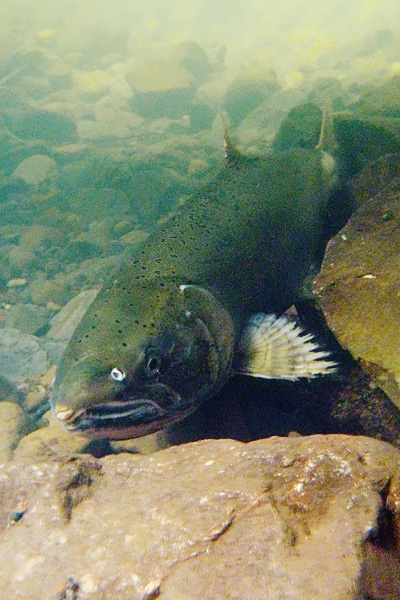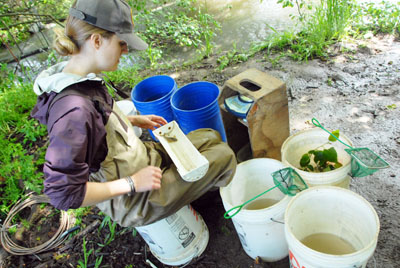Endangered coho salmon in coastal streams within the Golden Gate National Recreational Area and Point Reyes National Seashore may be on the verge of disappearing from these sites. These populations are affected by what happens in both their stream and ocean habitats.

Jessica Weinberg McClosky / NPS
Spawning stocks of coho salmon (Oncorhynchus kisutch) along the central California coast are only at about 1% of historical levels. Stream and floodplain habitat loss as well as fluctuations in ocean conditions have all contributed to this decline. Coho are vulnerable to changes in both habitats because they live in freshwater streams when they are young but spend most of their adult lives out at sea.
Young coho only thrive in streams that are cool, with unobstructed water flow, and adequate oxygen. They also need places where they can feed and shelter from strong currents that can wash away unprotected eggs and juveniles. Additionally, those young fish that find enough food and shelter are bigger when they leave the stream to go out to sea, and are more likely to survive to adulthood. Once in the ocean, large-scale weather and ocean patterns that drive nutrient cycling—and therefore how much food the coho find—largely determine how many will survive to breed. Because they require both high quality stream habitats and good ocean conditions, coho are excellent indicators of the health of these ecosystems.
Monitoring Program

Jessica Weinberg McClosky / NPS
Long-term monitoring of coho salmon has shown that the survival of young fish is closely tied to stream and floodplain habitat quality, and that changing ocean conditions and climatic events have a huge impact on adult coho while they are at sea.
The National Park Service (NPS) and their partners have been monitoring coho in Marin County streams since 1997. Data from this program have helped track and explain some of the fluctuations in these populations over time. For example, between 1999 and 2005, more coho returned to spawn in Redwood Creek after an El Niño event improved ocean productivity. However, a period of reduced nutrient upwelling in 2005-2006 led to large declines in 2007-2008 when a whopping 97% fewer coho returned than in the previous generation. Other streams in the region also saw a significant, yet less dramatic, 73% decline.
Monitoring showed that the young fish that went out to sea that season were smaller than in previous years, and also smaller than the regional average. Biologists believe that a lack of refuge habitat caused the juvenile coho to expend time and energy hanging on to their position in the stream during high flows rather than on feeding. Ocean nutrient upwelling was also delayed that year so the already undersized fish probably found little food once at sea.
Current Status
While NPS cannot control what happens in the ocean, they have undertaken large-scale restoration projects to improve coho habitat on the lands they manage, including:
Lower Redwood Creek
Redwood Creek begins high on Mt. Tamalpais, passes through Muir Woods National Monument, and eventually empties into the Pacific Ocean at Muir Beach. Over the years the lower reaches of the creek were altered by agriculture and development to the point where critical habitat for coho and other important species was lost. In 2003, NPS began the restoration of a the former Banducci flower farm along the creek. They restored the historic floodplain, removed invasive vegetation, and planted native species. They also installed log jams in the stream to create deep pools and restore the natural meandering bends in the creek. In 2009, NPS began another multi-year project to recreate a functional, self-sustaining ecosystem at Muir Beach, downstream from the Banducci site. When complete, the project will realign the stream, restore dunes and native vegetation, and increase refuges like floodplains, backwater areas, and deep pools that shelter vulnerable young coho.

NPS
Lagunitas Creek and the Giacomini Wetlands
Prior to the 1900s, Lagunitas Creek fed into the largest wetland complex in Tomales Bay, but by the late 1940s most of these wetlands—and the floodplains of Lagunitas and Olema Creeks—had been turned into pasture for the Giacomini Dairy Ranch. Lagunitas Creek supports the highest spawning population of coho salmon in the region; however, the number of returning spawners is much lower than historic levels. In the summer of 2008, NPS restored these dairy pastures to wetlands and floodplain that now provide foraging, resting, and breeding habitat for a myriad wildlife including refuge for young coho during high flows, and rich feeding grounds as they are migrating out to sea.

Robert Campbell
Additional Resources: For more information see https://www.nps.gov/rlc/pacificcoast/coho-steelhead.htm
Prepared by the San Francisco Bay Area Network Inventory & Monitoring Program, 2011.
Tags
- golden gate national recreation area
- muir woods national monument
- point reyes national seashore
- coho salmon
- fish
- endangered species
- monitoring
- wetland communities
- marine ecosystems
- climate
- sfan
- pcslc
- resource brief
- redwood creek
- lagunitas creek
- giacomini wetland restoration project
- giacomini wetland
- giacomini wetlands
- creek
- olema creek
- climate change
Last updated: December 23, 2020
